Button mushrooms and shiitake mushrooms are two of the most popular types of mushrooms, and ones that you can easily find at a grocery store or in a list of ingredients for tasty pasta dishes or soups. However, knowing which species to use can be confusing. Many people are not familiar with the differences in how mushrooms are cultivated and do not know how to identify their different flavors. When should you use a button mushroom? If you don’t like the taste of a shiitake, should you assume that you will not enjoy a button mushroom either?
Though button mushrooms and shiitake mushrooms are two of the most well-known and widespread species, if you can’t tell them apart, you are not alone! This article compares and contrasts the appearance, history, taste, and uses of each. By the end, you will know how to identify each and understand some of their major similarities and differences. Let’s learn about these two mushrooms now!
Comparing Button Mushrooms vs. Shiitake Mushrooms
| Characteristic | Button Mushrooms | Shiitake Mushrooms |
|---|---|---|
| Scientific Name | Agaricus bisporus | Lentinula edodes |
| Genus | Agaricus | Lentinula |
| Family | Agaricaceae | Marasmiaceae or Omphalotaceae |
| Division | Basidiomycota | Basidiomycota |
| Kingdom | Fungi | Fungi |
| Common Name | Button mushroom, white button mushroom, white mushroom | Shiitake mushroom, shitake mushroom |
| Origin | Asia, Europe, and North America | East Asia |
| Description of Fungus | Agaricus bisporus is an edible fungus in the Agaricus genus of the Agaricaceae family. When harvested at the youngest stage of maturity, it is called a “button mushroom.” At this early stage, the button mushroom is small, white, and mild in flavor. They have smooth, rounded, and sponge-like caps, which cover light brown gills, and smooth white stems. When harvested as a “button mushroom,” Agaricus bisporus typically has rounded, smooth caps that are from as small as half an inch across to up to 3 inches in diameter. | Lentinula edodes is an edible fungus in the Lentinula genus of the Omphalotaceae family. This fungus is commonly known as a “shiitake mushroom.” The shiitake has a brown, umbrella-shaped cap, with edges that curl inwards, a white or cream-colored stem, and white or cream-colored gills underneath the cap. The size can vary, with the smallest shiitake mushrooms harvested at less than an inch in diameter and the largest at 3.5 to 5 inches across. |
Descriptions of Button and Shiitake Mushrooms
Button mushrooms, Agaricus bisporus, and shiitake mushrooms, Lentinula edodes, are both edible species of fungi in the Basidiomycota division. They are also two of the most common edible mushrooms in the world. Though they have some similarities and may even look comparable at first glance, the two different species have several significant differences. This article explores the differences in their appearance, history, taste, and use. Let’s learn more about button and shiitake mushrooms now!
Description of Button Mushrooms
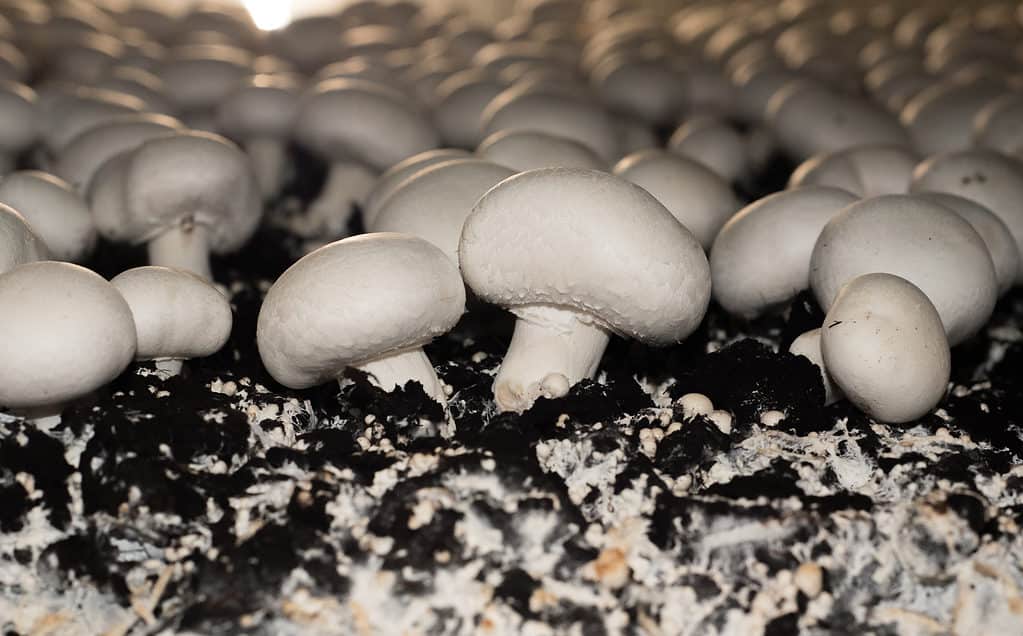
, or button mushrooms, are mild in flavor, but a popular culinary choice for many.
©ArliftAtoz2205/Shutterstock.com
“Button mushroom” is one of several names for the Agaricus bisporus species when it is harvested at its youngest stage of maturity. The Agaricaceae family, which Agaricus bisporus is part of, includes multiple edible species of mushrooms and some of the most popular mushroom species cultivated today. Agaricus bisporus is cultivated in dozens of countries across the world and is the most commonly-cultivated mushroom for human consumption in the United States. The species is particularly popular when harvested at its youngest stage of maturity, when the mushrooms are small, white, and have a tender texture and mild flavor. As the mushroom grows and matures, it loses water and develops a more meaty texture and earthy flavor as a result. At the intermediate stage of maturity, the species is called a “baby bella” or “crimini” mushroom. When fully mature, the species is called a “portobello” or “portabella” mushroom.
While at the youngest stage of maturity, Agaricus bisporus is known as a “button mushroom.” Button mushrooms are typically very small, white or cream-colored, and mild in flavor. Their smooth, rounded white caps have a firm but sponge-like texture. The caps curl under slightly to cover light brown gills, which will eventually become darker brown as the mushroom matures. The smooth white stems will also become thicker and woodier in texture as they mature, but those of the button mushroom are still tender. At this point, the caps of the button mushrooms reach up to 3 inches across, though most are harvested when much smaller. Button mushrooms go by several other names and are also commonly known as “white button mushrooms” or “white mushrooms.”
Description of Shiitake Mushrooms
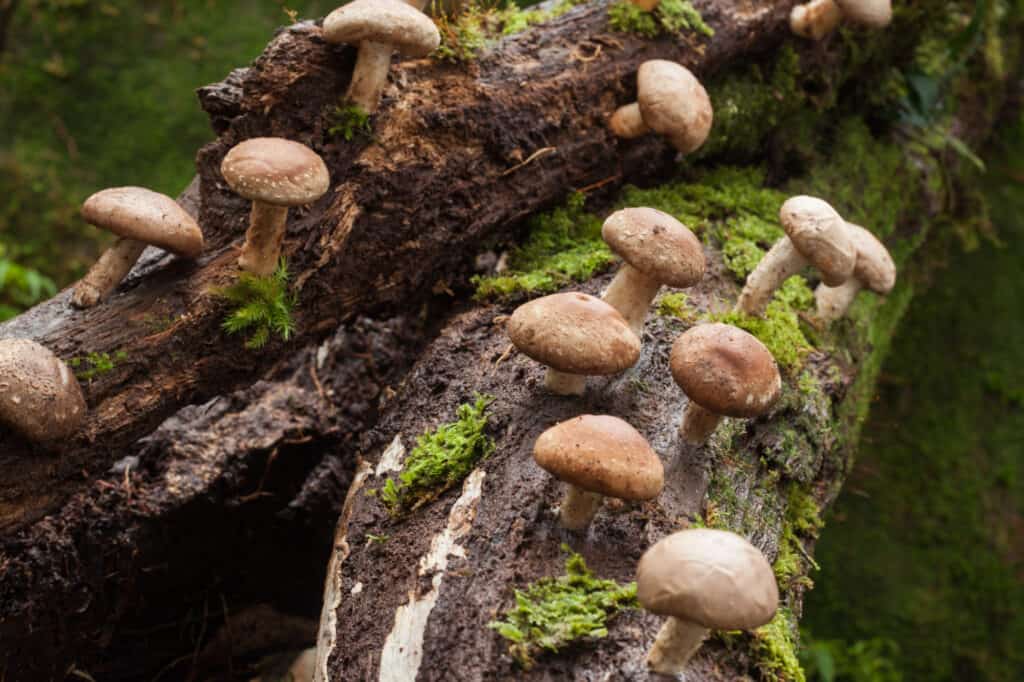
Most shiitake mushrooms are sold dried or fresh.
©puttography/Shutterstock.com
The name “shiitake mushroom” refers to the species Lentinula edodes, which is a mushroom originally cultivated in Japan and other countries in East Asia. Today, shiitakes are one of the most commonly-cultivated edible mushrooms in the world. They are a species in the family Marasmiaceae, which is also known as the Omphalotaceae family. This family contains more than 50 genera and over 1,500 species, with shiitake mushrooms one of the most widely consumed.
Shiitake mushrooms also go by “shitake,” “dongo,” “shanku,” “oak mushroom,” “black forest mushroom,” and other names. The name “shiitake” comes from the Japanese “Shii.” This refers to the evergreen tree where shiitake mushrooms grow.
Shiitake mushrooms have brown, umbrella-shaped caps. The caps have edges that curl inwards to cover white or cream-colored gills underneath. Shiitakes have white or cream-colored stems, which may darken into brown as the mushroom matures. Shiitakes vary greatly in size. The smallest shiitake mushrooms are harvested at less than an inch in diameter. However, larger ones can be 3 to 5 inches across! This means that an average shiitake mushroom may be quite larger than a small button mushroom.
When eaten, shiitake mushrooms have a smoky flavor and rich texture.
Key Differences
Because button mushrooms and shiitake mushrooms are both edible fungi, look similar, and can be found in the appropriate section of the grocery store, many people have a difficult time telling them apart. However, there are some significant differences that can help you tell the two apart and identify which to use. Let’s explore these qualities in greater detail now.
Button Mushrooms vs. Shiitake Mushrooms: History
People have long foraged for wild mushrooms. Cultivating mushrooms is also an ancient practice, with the first references to mushrooms coming from thousands of years ago.
Button Mushroom History
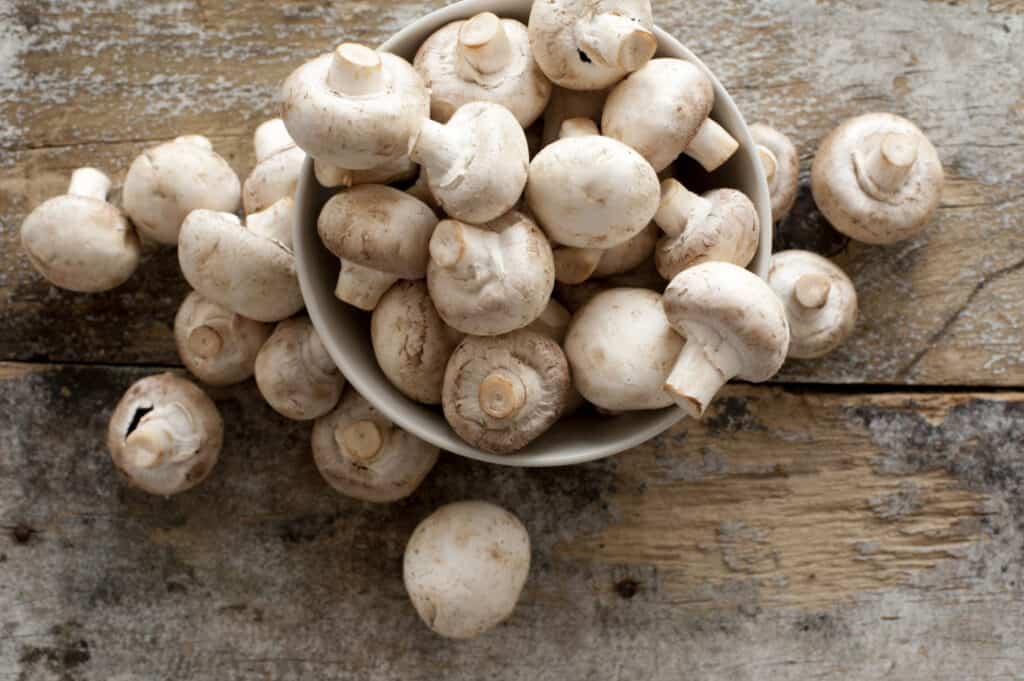
People in countries like France began cultivating button mushrooms for eating in the 16th and 17th centuries.
©Stephen Gibson/Shutterstock.com
Button mushrooms grow natively in climates across North America, Europe, and Asia. However, button mushrooms first gained wide popularity in Europe in the 1500s and 1600s. At this time, people in countries such as France began intentionally cultivating button mushrooms to eat. Larger-scale production grew significantly in the 1600s and 1700s. Though button mushrooms grow natively in cooler climates, people now cultivate them across the world. Dozens of countries use techniques and technology to replicate the button mushroom’s natural growing environment. Today, countries such as Poland and the Netherlands lead in the production of button mushrooms. However, you can also find button mushrooms in high production in countries including Canada, the United States, South Korea, and others.
Shiitake Mushroom History

Asian cultivators grew shiitake mushrooms using the traditional method to do so well into the 20th century.
©itchima/Shutterstock.com
Shiitake mushrooms come from the other side of the world. They are originally from East Asia, especially the mountainous areas of China, Japan, Taiwan, and other nearby countries. In these places, people use shiitakes for culinary and medicinal purposes and have for more than 1,000 years. Shiitake mushrooms grow naturally on hardwood trees. Ancient Japanese people began the practice of cutting wood to use to cultivate new growth through the process of inoculation. This brings the fungus spawn into contact with the log to cultivate the mushrooms on a new piece of wood.
Asian cultivators grew shiitake mushrooms using the traditional method well into the 20th century. It wasn’t until a few decades ago that cultivators started the first shiitake farms in the United States. However, since the 1880s, shiitake production has grown exponentially. Today, shiitakes are one of the most popular mushrooms in the world. They have spread from Asia and the United States to many other countries, where cultivators use new varieties to cultivate shiitakes for culinary and medicinal use.
Button Mushrooms vs. Shiitake Mushrooms: Appearance
Button mushrooms are small and have white or cream-colored stems and brown gills. Their texture is sponge-like yet firm. Though shiitake mushrooms are often similar in size to button mushrooms and also have white or creamy stems, their caps are tan or brown in color. While button mushrooms have white caps that hide brown gills, shiitake mushrooms have brown caps that cover white gills. Additionally, though the stems of a button mushroom will remain white or creamy off-white, the white stem of a shiitake may darken into brown as the mushroom grows.
Button Mushrooms vs. Shiitake Mushrooms: Growing Conditions
Growing Button Mushrooms
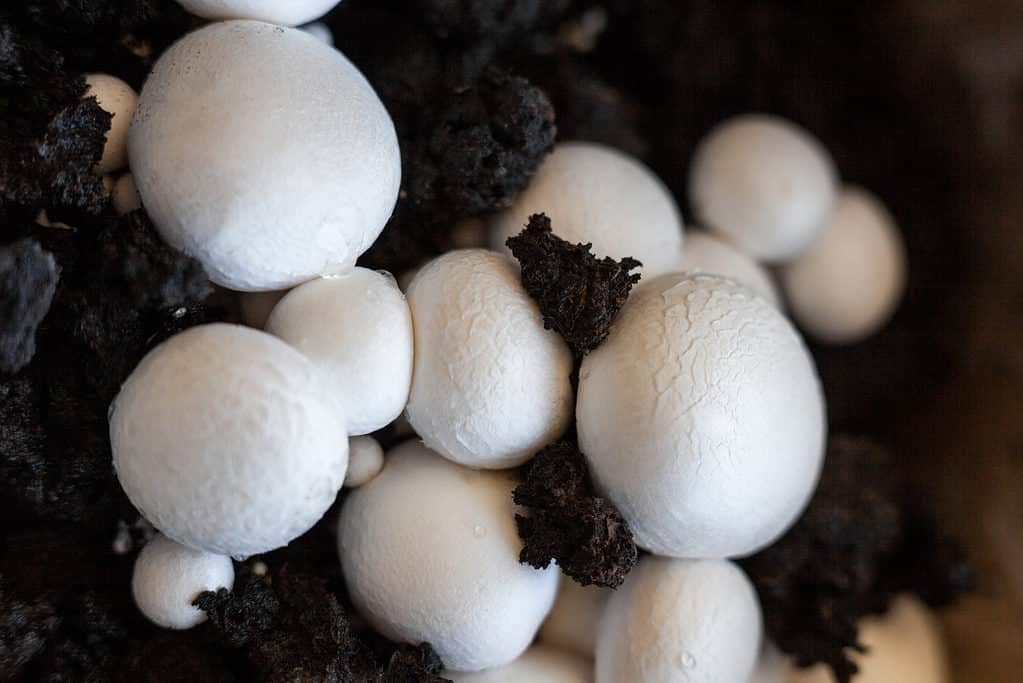
To grow button mushrooms, a moist, grassy environment is necessary.
©rootstock/Shutterstock.com
Button mushrooms grow naturally in moist, grassy areas. Pastures can provide an ideal growing environment because they often have grass and damp, fertile soil that is rich in animal manure. When attempting to replicate this environment to cultivate button mushrooms, cultivators can use animal manure or a combination of manure and compost.
When cultivating button mushrooms, it is important to keep the soil sufficiently warm but not too hot, with a goal temperature of around 70 degrees Fahrenheit. Button mushrooms grow naturally in countries with climates such as that found in Western Europe, in countries such as Poland and the Netherlands. This soil warmth is needed for the fungus to spawn and begin developing a mycelium web without becoming too hot. The mycelium will develop and spread across the top of the manure, eventually sprouting mushrooms. When you are ready to harvest the newly-formed button mushrooms after a few weeks of growth, twist them gently out of the dirt.
Growing Shiitake Mushrooms
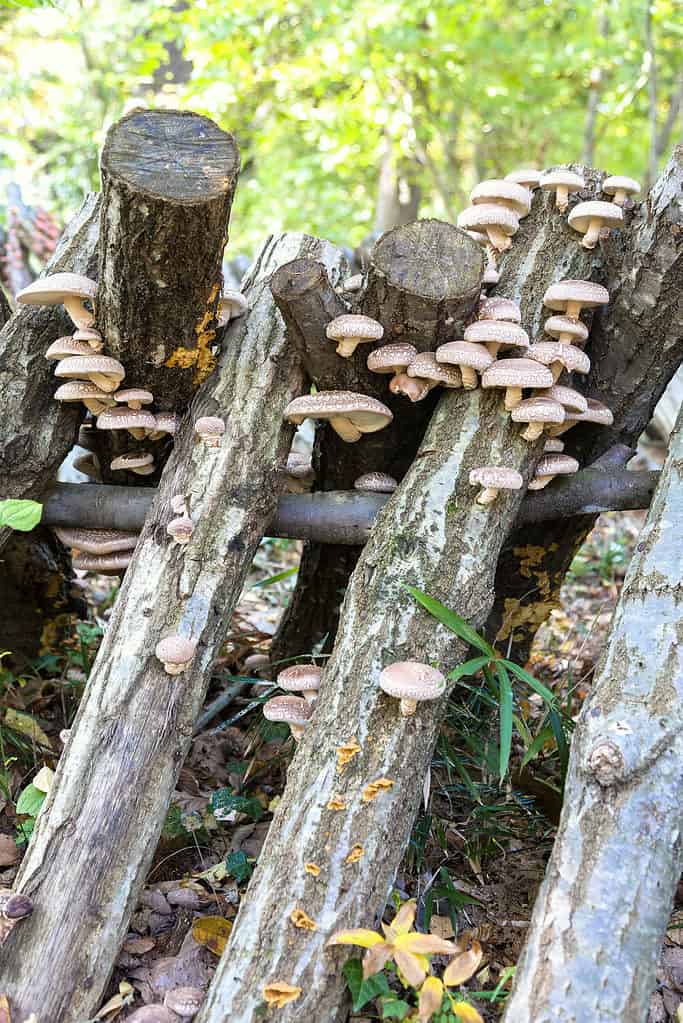
Shiitake mushrooms grow on hardwood species of trees.
©janken/Shutterstock.com
In comparison, shiitake mushrooms originate from East Asia, specifically Japan. Like button mushrooms, they begin as a mycelium. However, rather than growing in nitrogen-rich, moist soil like button mushrooms do, shiitake mushrooms need wood to grow. They are saprotrophs. Saprotrophs are organisms that feed on the tissue of dead trees. The mycelium of a shiitake mushroom feed specifically on hardwood species. The mycelium digests the wood’s cellulose and lignin. These provide the nutrients the fungus needs to grow. In order to help your shiitake mushroom thrive, you need to identify a host: ideally a sugar maple or white oak tree log. When the wood is harvested in the fall or winter, it has high sugar content, tight bark, and lots of moisture, all of which provide the optimal environment for a shiitake mycelium to feed.
If you would like to grow shiitake mushrooms, you may inject spores into a log about two to four weeks after the log has been cut from a tree. This is called “inoculation.” After feeding on the wood, the fungus will eventually produce the mushroom fruit, which then may be harvested.
Button Mushrooms vs. Shiitake Mushrooms: Taste
Button mushrooms have a very mild flavor and a tender and slightly chewy texture. Every part of the button mushroom is edible, and you do not need to do too much extensive preparation in order to eat the mushroom because you can eat the cap, gills, and stem. Because of their mild flavor, many cooks add button mushrooms to dishes in combination with other mushrooms that bring a more robust flavor. Button mushrooms may be eaten either raw or cooked.
In contrast, shiitake mushrooms have a strong, smoky flavor. They have rich texture and flavor, which bring a unique flavor to soups and sautéed dishes such as stir fry. Shiitake mushrooms are sold fresh and dried, and you may notice that dried shiitakes have an even stronger scent and flavor than fresh ones, which have an earthy fragrance. Compared to button mushrooms’ mild taste, shiitakes have a much smokier and more savory umami flavor. This is enhanced when the mushrooms are dried and is one reason why using dried shiitakes is a popular choice for many cooks, particularly when creating soups or stews. However, if you are intimidated by the strong flavor of a shiitake, perhaps you can start by eating a button mushroom. In comparison with the shiitake, a button mushroom’s mild flavor can be a low-key way to begin trying edible fungus species for the first time!
Unlike button mushrooms, many doctors caution people against eating shiitake mushrooms raw. Some people have had strong skin reactions called toxic flagellate dermatitis in response to the lentinan compound contained in the shiitake mushroom.
Button Mushrooms vs. Shiitake Mushrooms: Uses
When cooking either button or shiitake mushrooms, cooks recommend that rather than washing your mushrooms with water, you use a cloth to wipe away dirt. This is to avoid making your mushrooms mushy from absorbing too much water. If this makes you nervous, you may rinse your mushrooms gently before quickly using a towel or cloth to pat them dry.
When preparing button mushrooms, you have very little work to do! Simply trim the very end of the stems. From there, you may add the mushrooms whole to a recipe, or slice them. Eat them raw as a garnish or addition to a salad, or add them to a dish such as pasta, pizza, or stir fry!
However, when preparing shiitake mushrooms, you have a bit more work to do. If you are using fresh shiitakes, start by removing the entire stem. While button mushroom stems are entirely edible and have a similar texture to the cap, shiitake mushroom stems can be tough. Either discard the stems or save them to use in making a vegetable broth! If you are working with dried shiitake mushrooms, which is one of the most common ways to use them, you should start by soaking the mushrooms in water. The advice on how to do this best varies. Some cooks recommend soaking the shiitakes in cold water for about an hour. Others suggest that using very hot water is better – and this requires only about 20 or 30 minutes of soaking. Regardless, after soaking, strain the mushrooms and incorporate them into your recipe.
Shiitakes are a great addition to many different dishes – especially soups, pasta, stir fry, and broths.
Button Mushrooms vs. Shiitake Mushrooms: Health Benefits
In recent years, mushrooms have risen greatly in popularity for their purported health benefits.
Button mushrooms are exceptionally high in protein and are rich in vitamin D, vitamin B12, selenium, phosphorus, and folate.
In comparison, shiitake mushrooms have a high amount of natural copper, which supports strong bones, promotes healthy blood vessels, and boosts the human immune system. They also contain a compound called eritadenine, which reduces cholesterol and other compounds that protect your immune system and boost white blood cell production. Shiitakes are also known to have anti-inflammatory properties. Though they are not quite as rich in protein as button mushrooms, they serve as a good source of vitamins and minerals such as vitamin D, vitamin B6, folate, potassium, magnesium, iron, and many others.
Button Mushrooms vs. Shiitake Mushrooms: Storage
When fresh, you should store both button and shiitake mushrooms in the refrigerator in a towel or paper bag. This will keep them for approximately a week – don’t wait too long! If you do, you risk letting the mushrooms go bad and become slimy. If you are using dried mushrooms, keep them in a well-sealed container in a cool and dry place. This will allow them to stay good for months.
In Summary
This article examines the similarities and differences between button and shiitake mushrooms. Though both are popular, widespread edible fungi, they have different flavors, appearances, and growing conditions. Both have a long history and rich traditions, though they can from different parts of the world. Both can also be delicious and nutritious food to add to your diet. However, the one that you choose may depend on your preference for a robust mushroom taste and the dish you want to make.
The photo featured at the top of this post is ©
The information presented on or through the Website is made available solely for general informational purposes. We do not warrant the accuracy, completeness, or usefulness of this information. Any reliance you place on such information is strictly at your own risk. We disclaim all liability and responsibility arising from any reliance placed on such materials by you or any other visitor to the Website, or by anyone who may be informed of any of its contents. None of the statements or claims on the Website should be taken as medical advice, health advice, or as confirmation that a plant, fungus, or other item is safe for consumption or will provide any health benefits. Anyone considering the health benefits of particular plant, fungus, or other item should first consult with a doctor or other medical professional. The statements made within this Website have not been evaluated by the Food and Drug Administration. These statements are not intended to diagnose, treat, cure or prevent any disease.
Thank you for reading! Have some feedback for us? Contact the AZ Animals editorial team.






